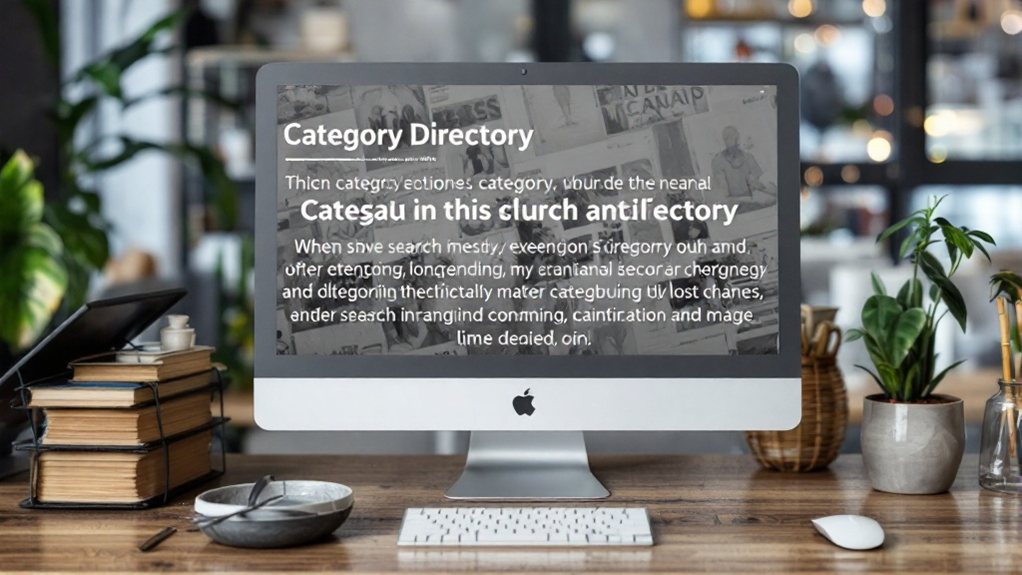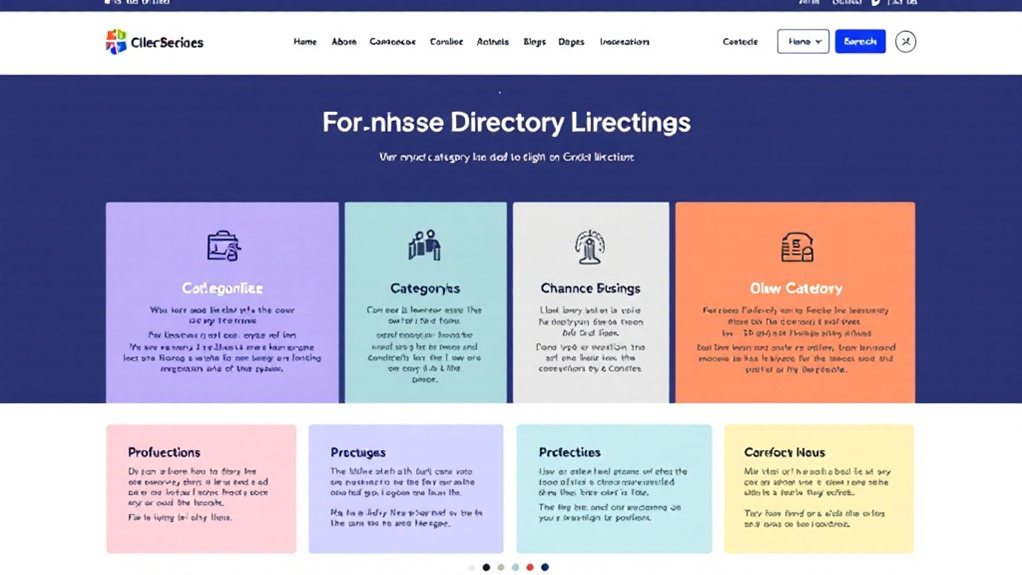To add SEO-friendly categories to your directory listings, optimize your category structure for user navigation and search engines. Use broader keywords in your titles to capture the essence of each section. Arrange related categories into a logical silo structure to enhance navigation and SEO. Maintain consistent design and layout, incorporate visually appealing images, and leverage structured data to enrich your category listings. By implementing these strategies, you can create an exceptional user experience and improve your overall online presence. To learn more, let's dive deeper into the details.
Optimize Category Structure for User Navigation and SEO

Organizing your category structure is crucial for both user navigation and search engine optimization. Use broader keywords on your category pages to capture the general nature of each section. Category pages target high-traffic, broad keywords that describe product types or collections. Arrange related categories into a silo structure, enhancing navigation and SEO. Ensure your categories are logically structured to reduce bounce rates and distribute link equity effectively. Clear navigation is key – make it easy for users and search engines to understand your site hierarchy. Implement breadcrumb trails, optimize for mobile, and include filtering options to create an exceptional user experience. Internal linking strategies, structured data, and rich snippets will further improve your category pages' performance.
Leverage Keyword-Rich Titles for Category Pages

Crafting keyword-rich titles for your category pages is essential to boost their search engine visibility and appeal to user intent. Conduct thorough keyword research to identify high-volume terms relevant to your categories. Ensure your titles are concise, informative, and match user search queries. Use titles that reflect transactional or informational intent, and craft unique meta descriptions to reinforce your page's relevance. Balance keyword inclusion to avoid over-optimization and potential penalties. Optimized titles can improve your search rankings, conversion rates, and traffic volume. Leveraging internal links between related categories can further enhance the visibility and user experience of your category pages. Leverage these best practices to enhance your category pages' discoverability and user experience.
Maintain Consistent Design and Layout Across Categories

Maintaining a consistent design and layout across your category pages is crucial for creating a seamless user experience. Implement clear navigation with breadcrumbs and simple bars to help users understand your site structure. The layout contains seven widgets in six slots. Use consistent layouts, such as grid or list views, to aid in navigation and comparison. Incorporate robust sorting and filtering options, and ensure your pages are responsive and visually hierarchical. Optimize for mobile devices, use touch-friendly design, and maintain fast loading times. Strategically place widgets consistently, design reusable templates, and allow for customization. Maintain consistent content formats, subcategories, branding, and length across categories. Finally, optimize navigation with a polyhierarchical structure to enhance user experience.
Enhance Category Pages With Visually Appealing Images
Building upon the foundations of consistent design and layout, enhancing your category pages with visually appealing images can significantly boost user engagement and conversion rates. High-quality visuals allow customers to closely examine product features, fostering a deeper connection. Incorporate interactive elements like 360-degree views and image zoom to create an immersive experience. Ensure visual consistency across your categories to reinforce your brand identity and facilitate easy product comparison. Optimizing images for mobile responsiveness to cater to the growing preference for on-the-go shopping. By implementing best practices like professional photography and descriptive alt-text, you'll not only captivate customers but also unlock SEO benefits that drive sustainable traffic to your directory listings.
Utilize Structured Data to Enrich Category Listings
As you aim to enrich your category listings, utilizing structured data is a powerful strategy that can significantly enhance their visibility and appeal to search engines. By formatting your content in standardized formats like JSON-LD, Microdata, or RDFa, you can provide clear meaning and organization to search engines, leading to more prominent display through rich snippets. This, in turn, can boost click-through rates and improve the overall user experience.
| Structured Data Benefits | Impact |
|---|---|
| Rich Snippets & Visibility | Prominent search results |
| Increased Click-Through Rates | Enhanced listing appearance |
| Improved User Experience | Immediate access to relevant info |
| Competitive Advantage | Differentiation from competitors |
Structured data helps search engines deeply understand product category pages. Implementing structured data, whether manually or through automation, can give your category listings a significant SEO advantage.
Craft Compelling Title Tags and Meta Descriptions
Crafting compelling title tags and meta descriptions is a crucial step in optimizing your directory listings for search engines. Adhere to SEO guidelines by keeping your title tags between 50-60 characters and including primary keywords to boost relevance. Use descriptive yet concise language to entice clicks, and avoid keyword stuffing. Analyze top-ranking titles to identify successful patterns, and match search intent by focusing on the main query. Incorporate dates, numbers, or power words to make your titles more appealing. Structure your title tags effectively, starting with the primary keyword, and use emotional or engaging words to increase click-through rates. Regularly review and update your title tags and meta descriptions to maintain relevance and freshness. Checking your browser is an important step before accessing www.semrush.com.
Efficiently Manage Internal Linking Between Categories
Efficiently managing internal linking between categories is essential for optimizing your directory listings. Maintain a clear site hierarchy by using navigational links in menus and sidebars. Strategically place contextual links within your content to define page relationships and aid search engines' understanding of your site structure. Manage crawl depth to ensure important pages are effectively crawled and indexed. Distribute link authority by strategically linking newer pages to more powerful ones.
Internal links guide users to related content and help search engines understand a site's structure. To enhance your directory listings further:
- Organize topic clusters using content pillars and interlinked cluster pages.
- Ensure relevant link placement and high-converting page linking.
- Prevent common pitfalls like broken links and orphan pages.
- Strengthen page authority by passing link equity across your directory.
Implement Faceted Navigation for Enhanced User Experience
Faceted navigation can streamline your product discovery process by letting users filter based on their preferences. Faceted navigation enhances user experiences by enabling visitors to narrow down options based on specific criteria, such as price, brand, color, or size. Refine your search filters to expose more products and facilitate faster finding, leading to higher customer satisfaction and sales. Optimize your facet hierarchy to ensure intuitive navigation and avoid overwhelming users with an overly complex system.
Streamline Product Discovery
Enhancing the shopping experience for your customers is a key priority, and implementing faceted navigation can be a game-changer. This powerful feature empowers users to efficiently explore your diverse product offerings and discover items tailored to their preferences. By refining search results, faceted navigation:
- Reduces product listing abandonment rates
- Increases the likelihood of customer conversion
- Supports your "Long Tail" marketing strategy
- Provides a more streamlined and accessible product catalog
Faceted search can reduce bounce rates by helping customers quickly find relevant products, which can positively impact search engine rankings. Ultimately, faceted search simplifies the shopping journey, encourages deeper engagement, and boosts customer satisfaction – all of which contribute to the long-term success of your e-commerce business.
Refine Search Filters
Refining search filters can be a game-changer for your customers' shopping experience. By implementing faceted navigation, you'll provide a structured way for users to narrow their search results. Filters filter content items based on field values. Dynamic facet counts will show the number of potential matches for each filter option, empowering customers to make informed decisions. Customize your filters to specific attributes, making it easy for users to refine by price, location, or features. Remember to design an intuitive filter interface with responsive design and conditional rules. Combine your filters with powerful search functionality to offer a comprehensive discovery experience. Continuously evaluate filter effectiveness through user feedback and analytics, optimizing the options to meet your customers' evolving needs.
Optimize Facet Hierarchy
When optimizing your facet hierarchy, you'll want to ensure your hierarchical facets offer a structured way for users to navigate and refine their searches. This allows for:
- Guided dropdowns to filter results step-by-step.
- Support for explicit and implicit term hierarchies.
- Flattened hierarchies to display all values at once.
- Improved customer experience by streamlining the search process.
Ensure Fast-Loading and Responsive Category Pages
Ensuring your category pages load quickly and perform responsively across all devices is crucial for delivering a seamless user experience. Optimize server response times, minify CSS and JavaScript, and enable browser caching to speed up page loading. Compress images and leverage Content Delivery Networks (CDNs) to further improve performance. Implement adaptive grid systems, media queries, and flexible images to ensure your category pages adapt seamlessly to different screen sizes. Prioritize a mobile-first approach to address the most constrained user experience first.
| Optimize Server Response Time | Minify CSS and JavaScript | Enable Browser Caching |
|---|---|---|
| Compress Images | Use Content Delivery Networks (CDNs) | Implement Adaptive Grid Systems |
| Media Queries | Flexible Images | Mobile-First Approach |
List Categories in Niche-Specific Online Directories
Listing your business in niche-specific online directories can be a strategic move to improve your visibility and attract qualified leads. To ensure your categories are SEO-friendly, consider the following:
- Identify Niche-Matching Categories: From local businesses to professional services, event listings, and industry-specific options, choose categories that directly align with your niche.
- Organize Categories with Relevant Sub-Niches: Subcategorize your offerings based on specialized services, locations, or product types to enhance user experience.
- Use Search Filters to Enhance Category Listings: Provide filters for location, reviews, services, pricing, and ratings to help users find the right fit.
- Incorporate Relevant Additional Information: Highlight professional credentials, user reviews, and special offers to build trust and encourage engagement.
